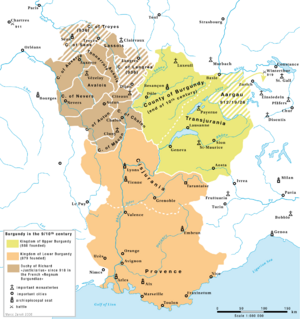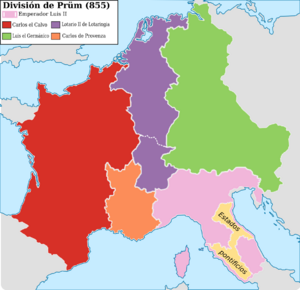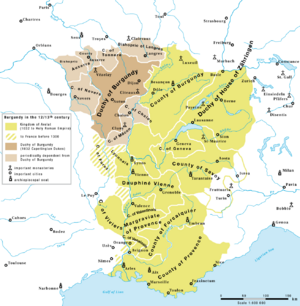Upper Burgundy facts for kids
Quick facts for kids
Kingdom of Upper Burgundy
|
|
|---|---|
| 888–933 | |
| Common languages | Vulgar Latin, Old High German |
| Government | Kingdom |
| Historical era | Early Medieval |
|
• Established
|
888 |
|
• Disestablished
|
933 |

The Kingdom of Upper Burgundy was a territory in Europe during the Middle Ages. It was part of the larger Frankish Empire. This kingdom was created in 888 by a king named Rudolph I of Burgundy, who belonged to the Welf family.
Upper Burgundy was located in an area called Transjurane Burgundy. This name means "beyond the Jura Mountains". It also included the County of Burgundy, which is known today as Franche-Comté. The word 'upper' in its name means it was located higher up the Rhône river. This helped tell it apart from Lower Burgundy and the Duchy of Burgundy. In 933, Upper Burgundy joined with Lower Burgundy. Together, they formed the Kingdom of Burgundy. Later, this united kingdom became known as the Kingdom of Arles.
Contents
History of Upper Burgundy
Transjurania was originally a part of the Carolingian Empire. This empire was very large. Transjurania covered a big area, from the Jura Mountains to the Great St Bernard Pass in the Western Alps. It was mostly in what is now western Switzerland. This included cities like Geneva, Lausanne, and Sion. It also included parts of modern-day France and Italy.
In 843, the Carolingian Empire was divided by the Treaty of Verdun. The Transjurane lands became part of a short-lived kingdom called Middle Francia. This kingdom was ruled by Emperor Lothair I.
Kingdom of Lotharingia
After Emperor Lothair I died in 855, his kingdom was divided again by the Treaty of Prüm. Lothair I's second son, Lothair II, received a part of Upper Burgundy. This became part of his kingdom called Lotharingia. His younger brother, Charles, received Lower Burgundy and the Kingdom of Provence.
When Charles died in 863, Lothair II gained some northern areas of his brother's kingdom. The southern Provence area went to their oldest brother, King Louis II of Italy.
The Transjurane region was then ruled by a duke named Hucbert. He was related to King Lothair II. However, Hucbert lost his position after Lothair II divorced Hucbert's sister. In 864, Hucbert was defeated in battle. He was replaced by Count Conrad II of Auxerre. Conrad II, from the Welf family, ruled Transjurania as a margrave starting in 866.
Lothair II died in 869 without children. His kingdom of Lotharingia was then split between his uncles. Charles the Bald received the western part, and Louis the German received the eastern part. This happened with the Treaty of Meerssen in 870.
By 884, Emperor Charles the Fat had brought almost all the Carolingian lands back together. The only exception was the Kingdom of Provence in Lower Burgundy. This kingdom had been started by Boso of Vienne in 879. In 888, Charles the Fat was removed from power and died. This caused the Carolingian Empire to break apart again. The important nobles and church leaders of Upper Burgundy met. They chose Rudolph I, Conrad II's son, to be their King of Burgundy.
Kingdom of Upper Burgundy
At first, King Rudolph I tried to reunite Lotharingia. But the East Frankish king, Arnulf of Carinthia, strongly opposed him. So, Rudolph I had to focus on his own lands in Transjurania and Franche-Comté. Arnulf recognized Rudolph's rule in Upper Burgundy. However, Arnulf later made his own son, Zwentibold, King of Lotharingia in 895.
Rudolph I was married to Guilla of Provence (also known as Willa). She was likely a daughter of King Boso of Lower Burgundy. Rudolph I died in 912. His son, Rudolph II, became the next king. Rudolph I's widow, Guilla, later married Count Hugh of Arles. Hugh became King of Lower Burgundy in 924.
Rudolph II tried to make his kingdom bigger. He attacked areas of the German duchy of Swabia. In 916, he took the city of Basel. However, he lost some Swabian lands in 919. This happened when he was defeated by Duke Burchard II in the Battle of Winterthur. To make peace, Rudolph II married Burchard's daughter, Bertha.
After this, Rudolph II started fighting in the Kingdom of Italy. He joined forces with a rebellious margrave named Adalbert I of Ivrea. In 923, they defeated Emperor Berengar I at Fiorenzuola. The next year, Rudolph II was crowned King of Italy.
However, some nobles in Italy did not like Rudolph II. They called on his stepfather, Hugh of Arles, the King of Lower Burgundy. Hugh marched into Italy. Rudolph's father-in-law, Duke Burchard II of Swabia, came to help Rudolph. But Burchard II was killed at Novara. Hugh then forced Rudolph out of Italy. Hugh became King of Italy in 926.
In 933, Rudolph II and Hugh finally made a deal. Rudolph II gave up his claims to Italy. In return, he received Hugh's Kingdom of Lower Burgundy. This reunited the two Burgundian territories. Rudolph's family, the Welfs, continued to rule this united Kingdom of Burgundy. His successors were Conrad the Peaceful (937–993) and Rudolph III (993–1032).
When the Welf family line ended in 1032, Burgundy became part of the Holy Roman Empire. Emperor Conrad II added it as the third main kingdom, after Germany and Italy. From then on, the Holy Roman Emperor also held the title of Burgundian king. Later, in 1127, the title of a Burgundian 'rectorate' was given to the House of Zähringen. This referred to the old Transjurane margraviate.
Rulers of Upper Burgundy
Here are the main rulers of Upper Burgundy:
- Hucbert (ruled until 864)
- Conrad II, Duke of Transjurane Burgundy (864–876)
- Rudolph I of Burgundy (876–912), became king in 888
- Rudolph II of Burgundy (912–937), also became King of Lower Burgundy from 933
- Conrad I of Burgundy (937–993), also King of Lower Burgundy
- Rudolph III of Burgundy (993–1032), also King of Lower Burgundy
After Rudolph III, his family line ended. The Kingdom of Burgundy then joined the Holy Roman Empire.
See also
- Burgundy (disambiguation)
- Kingdom of Burgundy
- Duchy of Burgundy



